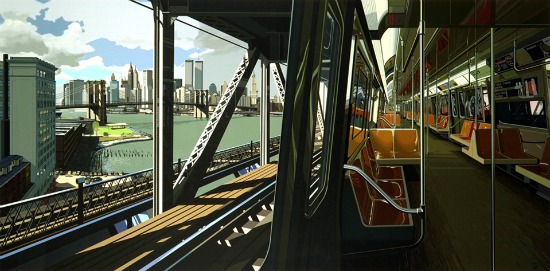“Richard Estes’ Realism” is the
most comprehensive exhibition of Estes’ paintings ever organized. A master of
contemporary realism, Estes is primarily known as a painter of the urban
landscape. The exhibition features nearly 50 paintings from Estes’ first mature
New York City facades from the late 1960s to panoramic views of Manhattan and
other cities and natural sites around the world.
Richard Estes, Double Self-Portrait, 1976, oil on canvas, 24 x 36 inches, The Museum of Modern Art, New York. Mr. and Mrs. Stuart M. Speiser Fund, 1976. © Richard Estes, courtesy Marlborough Gallery, New York. Digital image © The Museum of Modern Art/Licensed by SCALA/Art Resource, NY
Richard Estes, Double Self-Portrait, 1976, oil on canvas, 24 x 36 inches, The Museum of Modern Art, New York. Mr. and Mrs. Stuart M. Speiser Fund, 1976. © Richard Estes, courtesy Marlborough Gallery, New York. Digital image © The Museum of Modern Art/Licensed by SCALA/Art Resource, NY
Jointly organized by the
Smithsonian American Art Museum and the Portland Museum of Art in Portland,
Maine, the artworks in “Richard Estes’ Realism” are selected by Patterson Sims,
an independent curator, and Jessica May, curator of contemporary and modern art
at the Portland Museum of Art. Virginia Mecklenburg, chief curator at the
Smithsonian American Art Museum, is coordinating the exhibition in Washington,
D.C. The exhibition will be on view at the Portland Museum of Art from May 22
through Sept. 7 and at the Smithsonian American Art Museum from Oct. 10 through Feb. 8, 2015.
D Train, by Richard Estes. Photo courtesy of the
American Art Museum.
The exhibition explores the full range of Estes’ career as a painter. Widely acknowledged as a pioneering practitioner of photorealism, Estes’ sharply focused technique goes beyond the photographic to create complex constructions of light, reflection and perspective. Paintings in the exhibition balance Estes’ interest in cities with his explorations of the Maine coast and the woods on Mount Desert Island, where he has spent part of each year since the late 1970s. Most recently, Estes turned from luminous sunlit scenes to nocturnal images of New York City. Several of Estes’ rare portraits also are included in the exhibition.
The exhibition explores the full range of Estes’ career as a painter. Widely acknowledged as a pioneering practitioner of photorealism, Estes’ sharply focused technique goes beyond the photographic to create complex constructions of light, reflection and perspective. Paintings in the exhibition balance Estes’ interest in cities with his explorations of the Maine coast and the woods on Mount Desert Island, where he has spent part of each year since the late 1970s. Most recently, Estes turned from luminous sunlit scenes to nocturnal images of New York City. Several of Estes’ rare portraits also are included in the exhibition.
Ten Doors, 1972 Richard Estes Smithsonian
American Art Museum (Washington, DC)
Estes’
compositions—amalgamations of the multiple photographs he takes for each
composition—are dramatic and complex to the point of ambiguity. He layers and
merges multiple viewpoints to create dense and detailed scenes. Though figures
are often present in his work, they are—like most passersby in public
spaces—anonymous and uncommunicative. His seemingly effortless
technical finesse captures the intricate geometries of the city, the subtle
contours and nuanced tones of natural landscapes and the shimmering fluidity of
water. Estes’ realism is a compelling record of the appearance of urban and
natural environments in the late 20th and early 21st century.
About the Artist
Born in 1932 and raised in
central Illinois, Estes studied at the School of the Art Institute of Chicago
from 1952 to 1956. In 1959, he moved to New York City, where he has lived ever
since. For several years, he worked in commercial publishing and advertising as
a paste-up, layout and illustration artist. In the mid-1960s, Estes began to
paint from his own photographs, developing paintings that are rooted in Dutch,
Venetian and American representations of urban architecture. In 1978, the
Museum of Fine Arts in Boston organized the first major career survey of his
work, which was followed by his 1991 retrospective at the Portland Museum of
Art in Maine. Estes is considered the foremost practitioner of the
international group of artists known loosely as photorealists and has been
celebrated for more than 45 years as one of the premier painters of American
cityscapes.
Publication
“Richard Estes’ Realism” is
accompanied by a catalog with essays on Estes’ by Sims and May. The book also
includes a detailed chronology by independent art historian Helen Ferrulli. It
is published by the Portland Museum of Art and the Smithsonian American Art
Museum, and distributed by Yale University Press.
Credit
“Richard Estes’ Realism” is
organized by the Smithsonian American Art Museum and the Portland Museum of
Art, Maine.


